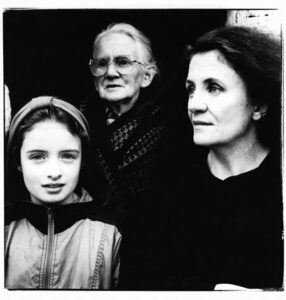I Could Read the Sky is a distinctive and rare integration of photography and fiction: it ‘is a collaboration in the shape of a lyrical novel, between writer Timothy O’Grady and photographer Steve Pyke’. In intense, often searing prose, it tells the story of an un-named man – he takes on many aliases in his itinerant years – coming of age in the mid-20th Century and leaving home. By the century’s end, ‘he finds himself alone, struggling to make sense of a life of dislocation and loss’. He recalls: his childhood marked by music, love and poverty in the west of Ireland; and his bewildering adult life of hard men and hard drinking, of hard labour in the fields, factories and building sites of England.
‘He is haunted by the faces of the family he left behind, and the land that is still within him. He remembers the country and the seascapes, the bars and the boxing booths, the music he played and the woman he loved.’ He carries little with him apart from an accordion and a good suit, made by ‘the Tailor’. He has photographs too: ‘Da by the house with a straw hat down over his eye and a grin on him like he’s just won at cards’; ‘Maggie raising a glass, the dress with bluebells’; and ‘me in the jacket Ma brought me that Fair Day in the town’. He remembers, ‘The blaze and pop of the photographer’s light in his little room above the tobacconist’s.’ He remembers the past as photographs: ‘The fuchsia and the new thatch, the emerald fields ringed in grey. The clouds close over us as we head out. A photograph.’ Photographs are his holders and makers of memories
‘The threnody of his days is also a succession of pictures and in their counterpoint – vivid, sensuous text and stark, harrowing, sometimes lovely images [mostly made in Ireland in the 1980s and 90s] – I could read the sky becomes a distillation of the experience of Irish emigration.’
In his introduction to the novel, John Berger writes: ‘The photographs bare a reminder of everything which is beyond the power of words … And the words recall what can never be made visible in any photograph.’ O’Grady, in his acknowledgements, pays tribute to Berger, who ‘fathered this book through his collaborations with Jean Mohr and his writing about migrant labourers’, such as Another Way of Telling (1982).


